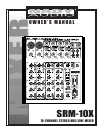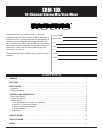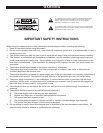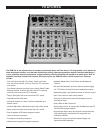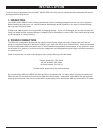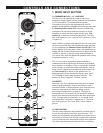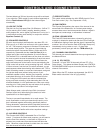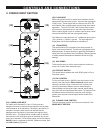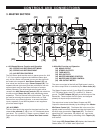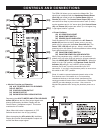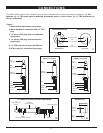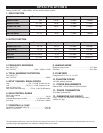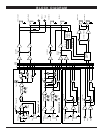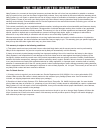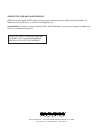
CONTROLS AND CONNECTIONS
The best balance of S/N and dynamic range will be achieved
if you adjust the TRIM control on each channel separately so
that the Peak Indicator LED (9) for that channel lights
occasionally.
(4) LOW CUT FILTER
Use this Low-Cut (high-pass) filter (18 dB/octave, -3 dB at 75
Hz) for reducing floor rumble, popping, breathing noises,
woolly bottom end, and to tighten up channels in a mix, etc. It
is most effective when used carefully in conjunction with the
Equalizer Controls (5).
(5) EQUALIZER CONTROLS
All mono input channels are fitted with a two-band EQ. All
EQs have up to 15 dB of cut and boost, with a center detent
for "off". The frequency response is flat when EQ knobs are in
the center detent position. The upper and lower shelving
controls have their frequencies fixed at 12 kHz and 80 Hz
respectively. Remember that the Low Cut filter (4) is an
integral part of the overall equalization of a mono channel.
The channel EQ is a valuable feature of the mixer as it allows
the user to control the tonal characteristics of each instrument
separately. For example, boosting the LOW can fatten the
sound and add punch to the bass or drums and adjusting the
HIGH control can provide a crisp sounding high end. With the
LOW set to boost, and the Low Cut switch activated, you get
peak response rather than shelving at the bottom end. This is
useful for adding warmth to vocals and instruments, and good
for tight but deep bass (without losing control of your
subwoofer speaker cones). Another very important, yet often
overlooked technique is to use the EQ to subtract from the
mix. Cutting the HIGH control can reduce unwanted hiss
during multi-track recording, while attenuating the LOW can
eliminate feedback in a live performance or clear up a muddy
sounding mix. Cutting away the top and bottom, then pushing
up the Gain is equivalent to mid range boost!
[Note: Always reset a channel’s input Gain (or external
devices’ output level) after altering the amount of mixer
equalization cut or boost applied.]
The key to successful equalization is to avoid excess. Too
much equalization on the input channels will result in a mix
that is smeared together with nothing specifically defined.
During rehearsals, experiment with the equalizer controls on
various instruments, vocals and combinations of these mixed
together to become familiar with various equalizer settings.
(6) AUX SEND CONTROLS
The Channel AUX SEND is selectable Pre or Post Gain
control. For almost all effects send purposes, you will want to
use the Post Gain selection, so that when a Gain level is
adjusted, any reverb send from that channel will follow the
fader. Otherwise, when the fader is pulled down, the reverb
from that channel will still be audible.
(7) PRE/POST SWITCH
This switch selects whether the AUX SEND signal is Pre or
Post Gain control. (Up = Pre, Depressed = Post)
(8) PAN CONTROL
The Channel Pan positions the output of the channel in the
stereo field of the Master Mix. Its constant-power design
ensures there are no level discrepancies whether a signal is
hard-panned, center-stage, or somewhere in-between.
(9) PEAK LED INDICATOR
The Peak LED illuminates when a channel is going into
overload. It detects the peak level after the EQ and will light
at 3dB before clipping to warn that the signal is approaching
overload. You do not want the Peak LED to light except very
intermittently during a take or a mix. If it does light
persistently, reduce input gain with the TRIM control (4).
(10) CHANNEL GAIN CONTROL
The channel gain controls determine the output signal level to
the Master Mix bus.
(11 & 13) PFL SWITCH
Channels 1-10 and TAPE IN channels all have PFL (Pre-
Fader Listen). This allows the Meter Display and CONTROL
ROOM/HEADPHONE outputs to monitor channel signals Pre
channel Gain controls.
[Note: When the PFL buttons are depressed, the AUX To
Meter switch should be in the off (up) position]
7



